Divergent and Convergent Thinking
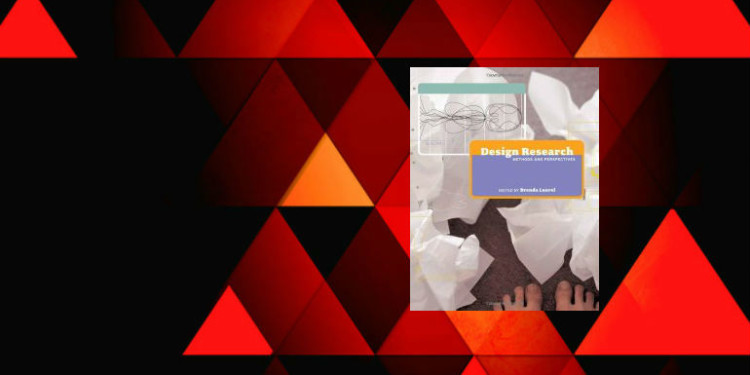
Design requires both expansive, exploratory methods (divergent thinking) as well as prioritization and focus (convergent thinking). Pairing the two approaches increases the chances of finding the most effective solutions.
Design Research: Methods and Perspectives by Brenda Laurel
Design Research is a collection of writings on various research tools and techniques available for designers. In addition to covering traditional design research topics like requirements gathering, ethnography, persona development, interviews, and field studies, the book also covers the usage of games and performing arts to discover market needs and inform understanding of audiences and problem domains. While many chapters cover exploration and discovery of the design problem and its users, several essays discuss the creative process in which research is necessarily embedded. The book also discusses creating a design culture and details like building a design library to encourage inspiration and experimentation. The editor of the book, Brenda Laurel, wrote Computers as Theatre (1991) and The Art of Human-Computer Interface Design (1990).
 In “Bringing Clarity to the ‘fuzzy front end'” Darrel Rhea discusses the early stages of product development which is often depicted as a cloud that empties into a funnel. The funnel is the Sorting Hat process which winnows down the multitude of potential projects into just the best ones. At the end of the funnel is a stage-gate process through which projects move from ideation to release.
In “Bringing Clarity to the ‘fuzzy front end'” Darrel Rhea discusses the early stages of product development which is often depicted as a cloud that empties into a funnel. The funnel is the Sorting Hat process which winnows down the multitude of potential projects into just the best ones. At the end of the funnel is a stage-gate process through which projects move from ideation to release.
This process is perceived as very mysterious and risky–there is no map of the terrain and anything can happen. In the face of that, only a genius with a brilliant insight can be successful. Those who wander in this cloudy realm are true wizards.
Because most people in organizations are interested in results, not process, this phase of development remains murky. Rhea calls this the “plumbing metaphor.” There is a high expectation for this stage of development–companies want discontinuous and disruptive innovation, not just incremental change. He suggests an alternative to a solely customer-oriented innovation, which is only one input to product and service innovation. Design research plays an important role in the “fuzzy front end” because this where customer insights and creative thinking are key activities and capabilities.
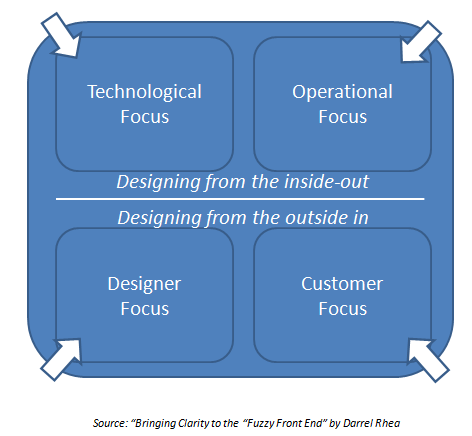 There are four sources of design: technological, operational, designer, and customer. Although customer insights and feedback are important sources of new product ideas and improvements, relying exclusively on customers can easily skew your road map. Customers may only see an immediate, local need and will not be aware of long-term impacts for your business and other customers. Moreover, customers are good at identifying problems and needs, but are not usually adept at finding a scalable and sustainable solution that is in alignment with your long-term strategy. Likewise, designing from the inside-out will likely result in solutions for which there is no problem and no customer willing to pay. Blending the four vectors will provide a balanced viewpoint. Operational focus will bring profitability and financial metrics into view. Technological focus will provide powerful capabilities as well as constraints. A design focus will, in Rhea’s words, “evoke desire”. Combining external perspectives with emotional intent and technological evolution will yield better results than a single focal point.
There are four sources of design: technological, operational, designer, and customer. Although customer insights and feedback are important sources of new product ideas and improvements, relying exclusively on customers can easily skew your road map. Customers may only see an immediate, local need and will not be aware of long-term impacts for your business and other customers. Moreover, customers are good at identifying problems and needs, but are not usually adept at finding a scalable and sustainable solution that is in alignment with your long-term strategy. Likewise, designing from the inside-out will likely result in solutions for which there is no problem and no customer willing to pay. Blending the four vectors will provide a balanced viewpoint. Operational focus will bring profitability and financial metrics into view. Technological focus will provide powerful capabilities as well as constraints. A design focus will, in Rhea’s words, “evoke desire”. Combining external perspectives with emotional intent and technological evolution will yield better results than a single focal point.
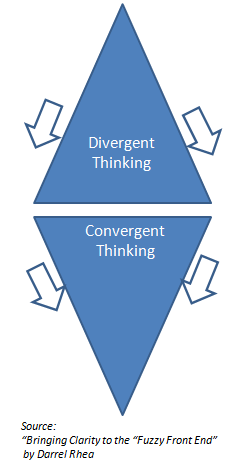 Rhea’s framework for the front-end of the funnel is a combination of first divergent thinking and then convergent thinking. There is a common theme in innovation literature that good ideas are found by having a lot of ideas. One of the reasons this can be true is that with just one or two options, it’s easy to accept a small number as being good. However, as a broad number of ideas is generated, it’s easier to see the spectrum of options and evaluate them. It’s easier to see the great ideas and bad ideas when there are lots of them–if there are just a few, they can all look good. Divergent thinking is the generator of the wide list of ideas. A study done by Karl Ulrich found that quality of idea rises for the first 100-200 ideas generated on a given topic at a point time, but decreases from there.
Rhea’s framework for the front-end of the funnel is a combination of first divergent thinking and then convergent thinking. There is a common theme in innovation literature that good ideas are found by having a lot of ideas. One of the reasons this can be true is that with just one or two options, it’s easy to accept a small number as being good. However, as a broad number of ideas is generated, it’s easier to see the spectrum of options and evaluate them. It’s easier to see the great ideas and bad ideas when there are lots of them–if there are just a few, they can all look good. Divergent thinking is the generator of the wide list of ideas. A study done by Karl Ulrich found that quality of idea rises for the first 100-200 ideas generated on a given topic at a point time, but decreases from there.
Divergent thinking
Discovery & observations, forecasting point of view, and identifying opportunities.
Rhea describes divergent thinking as emphasizing “broader, deeper, more original exploration than typical development.” Here, the focus is on “identifying significant new customer problems and opportunities.” By contrast, convergent thinking “prioritizes opportunities and emphasizes customer needs and desires.” The focus is on “creating compelling concepts with high probability of success in a time- and cost-efficient process.”
Rhea links design research with this divergent/convergent model by saying “research needs to be designed for discovery, not to track existing conditions and assumptions.” In the divergent phase, the goal is to break loose from current constraints and existing models of thinking about a problem. “New frontiers”, expansive perspectives, and original thinking exemplify this activity–“it’s not the pixels, it’s the picture”.
Convergent thinking
Prioritize opportunities, model the benefits, generate concepts, create models, refine concepts, build prototypes.
In the convergent phase, focus is the important attribute. The goal is to allocate resources and invest in high yield areas. Key areas of opportunity must be found amongst the universe of options and interesting avenues. Testing and validation in the form of modeling and experimentation. Problems are defined and solutions are generated to match. Success criteria are brought into the conversation and the set of available ideas are narrowed down. User scenarios are used to make problem+solution pairs concrete. A key part of convergent thinking is to establish a forward-looking point of view that makes assertions about consumer or customer behavior.
Perspectives on front end innovation
Rhea’s model demystifies the typically obscure “brainstorming” process and gives product development team a way to envision their design and opportunity evaluation methods. His depiction of the the front-end of product development is simple and useful–it helps to visualize the outward spread of a wide array of ideas which then narrow down before entering the traditional stage/gate process.
Rhea approaches the topic of front-end innovation from a design driven perspective, specifically focusing on how design research can come into play. The other authors below discuss the topic from educational, traditional business, strategic, and creative perspectives. Some common themes noted and observations made by all authors are:
- We are trained and rewarded largely for convergent thinking. This is largely why the “front-end” is “fuzzy” and not well understood.
- Customer and market insights are important raw materials for all activities that occur in this phase.
- Technological input is critical because it represents a driving force of change and possibility.
- A set of strategic goals, principles, and vision are important to frame, focus, and guide the solution process.
- The idea generation “engine” should be active all the time–innovation muscles get stronger with use.
- Ideas don’t have to be fully formed during this phase to move on to a more formalized evaluation.
Divergent thinking in education
This video is an excerpt of a talk given by Ken Robinson on changing educational paradigms. Here, he explains divergent thinking and how it decreases as we age:
The strategic framework
Product Arts describe the initial activities that result in a set of ideas to be fed into the product development process. They identify the primary activities as identifying gaps, creating concepts, and assessing opportunities. These are framed by business strategy and portfolio management. The external and internal boundaries/inputs are market drivers (market segments, buyers and users, competitors, technology) and company drivers (objectives, capabilities, resources, assets). This framework corresponds closely to the traditional management consulting SWOT analysis, gap analysis, and environmental scan.
The product development process
Peter Koen identifies several efforts which typically generate the ideas at the beginning of the product development lifecycle: customer trend analysis, technology trend analysis, technology road mapping, competitive analysis, and scenario planning. These external and internal inputs generate the raw materials for the ongoing selection activities that occur prior to the structured development process. He includes the concept of a 3 to 5 person “market attack team” that takes a high level charter and drives toward a business plan (a process much discredited by the lean startup movement). The metrics he suggests for concept selection are: technical success, commercial success, reward, strategic fit, and strategic leverage. “Getting out of the building” isn’t mentioned here, but Koen does say “the key issue is NOT picking the winners, but killing the losers early.” He’s also realistic and notes that you should “expect the project will morph into something else” along the way.
The creative context
Speaking from the perspective of someone interested in creativity, Tina Seelig breaks down convergent and divergent thinking, connecting & combining ideas, challenging assumptions, and reframing problems. Each of these approaches are useful in the generation and elaboration of opportunities and solutions during front end activities.

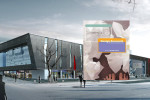

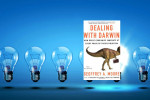
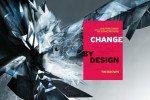
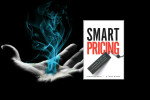

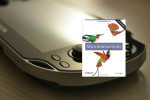
[…] trying to innovate. First, we have to explore a broad range of ideas. Olaf Kowalik writes about how to use divergent thinking to do this – and this is a key innovation […]